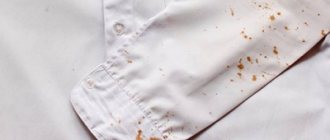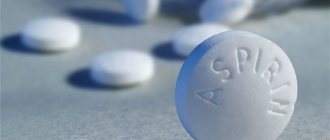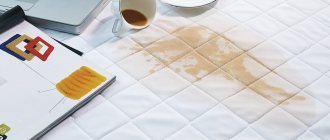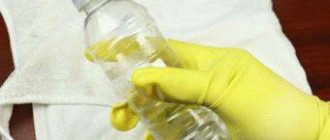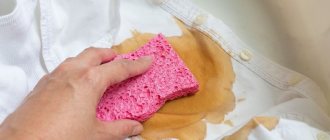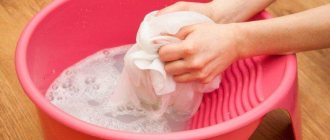Potassium permanganate or potassium permanganate has become firmly established in our everyday life and is used everywhere to disinfect and disinfect wounds and various solutions. It is used in agriculture and is even added to bath water for babies.
Potassium permanganate is a chemically active substance with a strong oxidizing effect. That is why, a few minutes after it hits any surface, the potassium permanganate stain turns from violet-burgundy to brown. You just can’t wash it off with water or remove it; it seems like it’s stuck forever. But still, there are means to remove such stains.
Is potassium permanganate washed off from clothes?
Plain water does not wash away manganese, even if the contamination is fresh. Washing powder and other detergents don't help much either. Therefore, many people throw away soiled clothes, believing that it is no longer possible to wash them.
In fact, the permanganate is washed off. You just need other means:
- various acids;
- alcohols;
- household bleaches (soda, peroxide, citrus juice).
If the stain has lost its characteristic shade of manganese and turned brown, it means that the permanganate has had time to interact with other organic substances. It is much more difficult to clean an item with brown stains.
Why potassium permanganate is not washed off with water
Permanganate penetrates very deeply into any material. It saturates most fabrics through and through. This reaction cannot be rinsed out with water, even if you add detergent. Water, on the contrary, increases the stain, helping it spread over unstained areas. It is necessary to use strong substances that act precisely and dissolve the dye.
How stains appear from a home medicine cabinet
The brilliant green solution is produced in glass jars, closed with a tight lid, which, in most cases, cannot be opened carefully.
And a small amount of antiseptic solution is always spilled on the skin of the hands, the surface of clothing or nearby furniture. Similar situations arise when using iodine and potassium permanganate. When such contaminants form, many send soiled items for recycling, thinking that they will no longer be able to save their favorite blouse or blouse. However, this is not the case, and such contaminants can be removed, but to do this, you should pay attention to the general recommendations for eliminating such contaminants:
- Treat all contamination from the edge to the center to prevent an increase in the perimeter of contamination.
- Before you begin removing existing stains using a particular product, it is recommended to test the interaction of fabric fibers with the selected cleaning product on an inconspicuous area of clothing. If nothing happens: the fabric has not faded or become deformed, then the selected product can be safely used for the washing procedure.
Methods for removing potassium permanganate stains
Most methods are based on the use of acids. Chemical preparations (ammonia, peroxide) are better at removing old stains. But in order not to ruin your clothes, you should start with more gentle products that you have in the kitchen.
Remember about dry cleaning. Even when attempts at home to wash an item are unsuccessful, chemical care will rid your favorite item of old stains.
Baking soda
Soda is a universal remedy. And she also easily copes with potassium permanganate:
- Dilute baking soda with water and stir. You should end up with a wet, paste-like mixture.
- Generously coat the contaminated area with the mixture.
- After 2 hours, rub a little with a sponge.
- Rinse under the tap (or wash in a machine).
If the material is not very delicate, you can enhance the effect of soda by mixing it with peroxide or vinegar instead of plain water. It is better to mix directly on the clothes - a chemical reaction will occur and make cleaning easier.
Lemon
Lemon juice is a good solution for potassium permanganate stains. You need to do this:
- Cut the lemon in half. Squeeze the juice into a small bowl.
- Remove the seeds and pulp that got into the container along with the juice - they can ruin the fabric.
- Soak a soft kitchen sponge in the juice. Rub into the stained area.
- Leave for about 30 minutes.
- Wash clothes by hand or in a machine.
Another method of using lemon helps if the potassium permanganate has managed to completely saturate the fabric. You need to cut the fruit in half, squeeze the soiled item of clothing between the halves and rub. This makes cleaning easier - regular washing with soap and water will remove any residue.
Lemon acid
Acid in crystals is used in the same way as lemon juice. First, you should moisten the stained area with water, and then sprinkle it with acid. It is better not to leave the product on clothes for longer than 15 minutes.
This acid is a strong bleach, so it is best not to use it on dark or brightly colored clothing.
Hydrogen peroxide
Peroxide (3%) works well to whiten clothes from manganese stains:
- Pour a little product onto the stain.
- Leave for 15 minutes.
- Rinse off with warm water.
- Repeat the steps until the clothes are completely washed.
It is better to treat delicate fabrics with peroxide, which has been previously diluted with water (in equal proportions). And to enhance the effect, peroxide can be mixed with lemon juice - also in equal parts.
Ammonia
Ammonia should not be left on the surface of the fabric - the substance harms both the dye and the material itself. It's better to use it this way:
- Add 1 tsp to a glass of water. ammonia. Stir thoroughly.
- Soak a cotton pad or swab with the resulting solution.
- Rub the mixture into the stain, replacing the cotton wool as it gets dirty. Continue these steps until the potassium permanganate completely dissolves and disappears.
Ammonia is not recommended for use on fabrics dyed in bright colors. Using this product may cause the dye to fade.
Kefir or yogurt
Fermented milk products have always been used to rid clothing of difficult stains.
It is better to use homemade yogurt (sold in markets), but in the absence of this, bottled store-bought kefir will do:
- Pour the curdled milk into a small bowl.
- Dip clothes. It’s not completely necessary - just soak the fragment covered with potassium permanganate.
- Soak for about 5 hours in the basin. You can leave it overnight.
- Remove and rinse with cold water.
The advantage of the method is its versatility. It suits any type of fabric, regardless of color. Dairy products do not harm the material and are able to clean potassium permanganate in any situation. But against old stains the product runs the risk of not being very effective.
Oxalic acid
Acid is sold in most pharmacies. To use it to clean clothes, you need to prepare a solution:
- Add 1 tbsp. l. substances in 100 ml of water and stir thoroughly.
- Pour the solution onto the stain and rub with a sponge.
- Leave on fabric for 5 minutes.
- Rinse the item with plenty of cold water. If potassium permanganate still remains on clothes, wash it in a machine with powder.
Tips and tricks
The main thing to remember when deciding to clean things from potassium permanganate at home is safety. It is recommended to wear protective gloves when preparing acid-based working solutions. The area of skin on which the concentrate has come into contact must be immediately rinsed with plenty of water. The bath is treated with the ventilation turned on or with the doors open.
After the procedure, the room is ventilated.
Glass and any other material can be cleaned with a soap and soda mixture. 100 grams of soap shavings are mixed until smooth with 2-3 tablespoons of baking soda and 100 milliliters of water. To give the product a pleasant smell, add 2-3 drops of essential oil.
Cleaning things and utensils from potassium permanganate is not as difficult as it seems at first glance. Household acids, baking soda and vinegar are effective in combating pink stains.
Medical manganese is sold in the form of crystalline powder in plastic or glass vials. The substance appears dark, almost black.
For use, potassium permanganate is diluted in ordinary water. When it comes into contact with liquid, it turns it pink. The thickness of the color depends on the dosage of the powder. To get a glass of bright pink water, just dissolve the crystals in it on the tip of a knife. Potassium permanganate has this color due to its unique chemical composition.
Interacting with oxygen, potassium permanganate oxidizes and turns brown. As stains of the substance dry, they become persistent and are difficult to remove from surfaces. This is again due to the special properties of potassium permanganate, its ability to penetrate deep into tissue and crystallize upon contact with air.
The thicker the solution of potassium permanganate, the more difficult it is to wipe it off.
How to remove stains from white clothes
White materials are difficult to clean using the methods mentioned above. This requires other methods, and you need to act quickly. If potassium permanganate manages to “eat deep” into the white fabric, then it will no longer be possible to completely wash the clothes - a yellowish stain will remain.
| Means | Description |
| Oxalic acid | Mix acid with water in a lower concentration than for colored items. For a glass of warm liquid, 1 tbsp is enough. l. facilities. The solution is applied for 5 minutes, and then washed with soapy water (with laundry soap or washing powder). |
| Hyposulfite solution (10%) | The substance is sold in photo stores and helps remove old stains. The product should not be left on the fabric for longer than 2 minutes. There is no need to wash it afterwards - just rinse with warm water. |
| Peroxide | This household bleach works well on light-colored fabrics. Use it according to the principle stated above. One difference is that it is better not to leave the product on a white fabric for longer than 7 minutes. |
| Laundry soap | Soap shavings are dissolved in hot (this is important) water. The entire contaminated clothing is soaked in the solution, and after 1-2 hours it is washed by hand. |
| Bleach (chlorine and oxygen) | It is better not to use bleach with colored items, but with white items it is acceptable. You can soak the clothes in water with bleach or do a full wash. |
Best answers
Delia Delia:
Potassium permanganate is an oxidizing agent. This means that we need to act as a reducing agent - hydrogen peroxide. sodium sulfite. Only the stain can go away with the fabric. Type in “stain removal” in the search - now there are a lot of products for different stains
Potassium permanganate stain
If you have ever splashed your clothes with a solution of potassium permanganate, then you remember very well how much you tried unsuccessfully to remove this stain! Stains from potassium permanganate are very persistent and cannot be removed by almost any means. Even bleach doesn't take them...
Most often, clothes stained with potassium permanganate simply have to be thrown away.
This problem is especially often encountered by doctors who often use potassium permanganate when treating patients. Stains on the robe remain forever, until the robe wears out... (I think that chemists are also familiar with this problem “in their own skin”).
However, if there is a poison, there must be an antidote!
There is a product for removing potassium permanganate stains and it is very simple. But few people know about him.
And the remedy is ordinary citric acid.
A fresh potassium permanganate stain should be slightly moistened and sprinkled with citric acid powder. Leave for 10-15 minutes, then rinse with water. Repeat if necessary.
Old stains, of course, will be more difficult to deal with. However, citric acid will remove them too - maybe not in one go, maybe not in 10 minutes, maybe not one hundred percent, but it will remove it or at least almost discolor it!
This recipe was tested on ourselves (we often had to use potassium permanganate at work), so use it!
gerta521:
Soak the contaminated area in whey or yogurt for 3-4 hours, then wash. Or dampen the stain and sprinkle citric acid powder, leave for 10-15 minutes, then rinse and wash.
Vicont De-brajelon:
black disappears from succinic acid,
Ilya Ivanov:
On white clothes (in particular medical gowns), old stains are removed with a combination of two Cillit Bang + Vanich Oxi Action products in exactly 5 minutes. The doctor himself checked by simple selection.
Features of cleaning different types of fabrics
Different fabrics require a unique approach. The described methods are not suitable for them or are ineffective.
| Fabric type | Means | Description |
| Silk | Oleic acid | This acid is applied to the stained fragment and left for 5-7 minutes - no longer needed. Then the item must be washed by hand. |
| Wool | Wood alcohol | This alcohol can be used to treat woolen clothes of any color. It is applied to the surface and left for no more than 20 minutes. To enhance the effect, you can mix alcohol with 9% vinegar in a 1:1 ratio. There is no need to wash after this treatment - just rinse under running water. |
| Denim | Peroxide and citric acid | Other methods are ineffective in cleaning jeans. Therefore, a mixture of peroxide and acid in equal proportions is often used. This mixture is applied to the stain and left for 10 minutes. Then rinse off with clean water and wash the jeans additionally. |
| Cotton | Oxalic and acetic acids | T-shirts and bedding made from natural cotton are best washed with these products. Apply according to the algorithms described earlier in the article. |
| Leather | Lemon | Clothes made of natural and artificial leather can be scrubbed with half or a slice of lemon. It is better to treat leather items not with squeezed juice, but with the fruit itself. |
| Delicate fabrics | Lactic acid | Kefir and other fermented milk products are one of the recommended methods for cleaning delicate materials. They will not harm even thin satin, and can be used without fear. |
Chemicals
Substances that have a chemical basis will help you wash off potassium permanganate from the skin of your hands; they are classified as potent. If the use of folk remedies does not give the expected result, then the following compositions are used:
- Solvents based on acetone or white spirit. Both substances dissolve paints well. White spirit or kerosene are gentler on the skin, while acetone is more toxic.
- The disinfectant chloramine is a derivative of ammonia, due to which it has a bleaching effect.
- Chlorine-based products, such as bleach. They are able to lighten not only things, but also characteristic manganese stains.
- Stain removers used to remove paint from clothing. These products first dissolve the dye and then bleach it.
All these drugs cannot be used in pure, undiluted form, as they are very aggressive and can cause even greater harm to already damaged tissue. With their help, you can remove a stain from the skin, but in its place a more serious type of injury may appear.
This method of removing stains is unsafe, so first you need to check the body’s reaction to the use of chemicals. If they do not cause redness or an allergic reaction upon contact with the skin, then their use is possible. Otherwise, you need to choose another option.
In the absence of contraindications, these products are used to wipe the affected area, and the procedure is repeated several times if necessary. It is not recommended to hold a tampon on the affected area for a long time, as these substances can cause skin irritation and provoke inflammatory processes.
For the most part, they are used to remove old stains, when manganese has penetrated deep into the skin, and the use of other means does not give the desired result.
To avoid drying out the skin and flaking as a result of such cleansing, you should use a nourishing cream each time , applying it in a thin layer.

